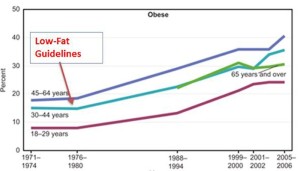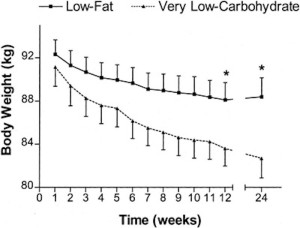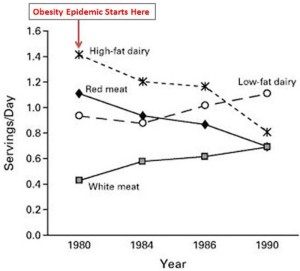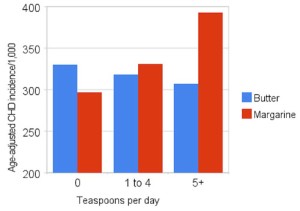The war on fat is the biggest mistake in the history of nutrition.
As people have reduced their intake of animal fat and cholesterol, the incidence of many serious diseases has gone up. We are now in the midst of worldwide pandemics of obesity, metabolic syndrome and type II diabetes.
Studies conducted in the past few decades conclusively show that neither saturated fat nor dietary cholesterol cause harm in humans. Scientists are now beginning to realize that the entire low-fat dogma was based on flawed studies that have since been thoroughly debunked.
Here are six graphs that clearly show how incredibly damaging it has been to advise people to reduce their consumption of animal fat.
1. In Europe, the Countries that Eat the Most Saturated Fat Have the Lowest Risk of Heart Disease
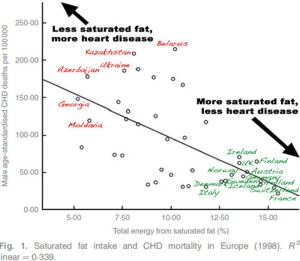
Saturated fat heart disease in europe – Data from: Hoenselaar R. Further response from Hoenselaar. British Journal of Nutrition, 2012.
The reason for this is simple, actually … the truth is that saturated fat simply has NOTHING to do with cardiovascular disease. There is no paradox. It was a myth all along.
Thanks to Dr. Andreas Eenfeldt for the enhanced graph.
2. The Obesity Epidemic in the USA Started at Almost The Exact Same Time the Low-Fat Dietary Guidelines Were Published
Low fat guidelines – Kris Gunnars – Source: National Center for Health Statistics (US). Health, United States, 2008: With Special Feature on the Health of Young Adults. Hyattsville (MD): National Center for Health Statistics (US); 2009 Mar. Chartbook.
Although this graph doesn’t prove anything (correlation does not equal causation), this does make sense because people started giving up traditional foods like butter in place of processed “low-fat” foods high in sugar.
Since then, many massive studies have been conducted on the low-fat diet. These studies show clearly that the low-fat diet does not cause weight loss and has zero effect on cardiovascular disease in the long term.
Despite the poor results in the studies, this diet is still recommended by nutrition organizations all over the world.
3. Diets that Are High in Fat But Low in Carbohydrates Cause More Weight Loss than Diets that Are Low in Fat
weight loss graph low carb vs low fatKris GunnarsSource: Brehm BJ, et al. A randomized trial comparing a very low carbohydrate diet and a calorie-restricted low fat diet on body weight and cardiovascular risk factors in healthy women. The Journal of Clinical Endocrinology & Metabolism, 2003.
If animal fat was as bad as they say, then diets that contain a lot of it should be both fattening and harmful to your health. However, the studies do NOT back this up.
In the study above, women eating a low-carb, high-fat diet until fullness lost more than twice as much weight as women eating a calorie restricted low-fat diet.
The truth is, diets that are high in fat (but low in carbs) consistently lead to much better results than low-fat, high carb diets.
Not only do they cause more weight loss, but they also lead to big improvements in pretty much all the major risk factors for diseases like cardiovascular disease and diabetes.
4. The Diseases of Civilization Increased as Butter and Lard Were Replaced with Vegetable Oils and Trans Fats
fat consumption in usa – Kris Gunnars – Source: National Center for Health Statistics (US). Health, United States, 2008: With Special Feature on the Health of Young Adults. Hyattsville (MD): National Center for Health Statistics (US); 2009 Mar. Chartbook.
In the 20th century, several serious diseases became common in humans.
The heart disease epidemic started around 1930, the obesity epidemic started in 1980 and the diabetes epidemic started around 1990.
Even though these diseases were almost unheard of before, they have now become the biggest health problems in the world, killing millions of people per year.
It is clear from the graph above, that these diseases have skyrocketed as animal fats have been replaced with shortening, margarine and processed vegetable oils.
5. The Obesity Epidemic Started as People Reduced Their Intake of Red Meat and High-Fat Dairy Products
fatty food consumption from 1980 to 1990 – Kris GunnarsSource: Hu FB, et al. Trends in the Incidence of Coronary Heart Disease and Changes in Diet and Lifestyle in Women. The New England Journal of Medicine, 2000.
It amazes me that some people still blame traditional foods like meat and butter for the diseases of civilization. These foods have sustained humans in good health for a very long time and blaming new diseases on old foods just doesn’t make sense.
All the data shows that people actually reduced their consumption of these foods as these diseases went up.
The graph above, from the Nurses Health Study, shows that Americans were reducing their intake of red meat and full-fat dairy at the same time the obesity epidemic was starting.
6. In the Framingham Heart Study, Heart Disease Goes up as People Replace Heart-Healthy Butter with Toxic Margarine
butter vs margarine
Stephan Guyenet Kris GunnarsSource: Gillman MW, et al. Margarine intake and subsequent coronary heart disease in men. Epidemiology, 1997. Photo source: Whole Health Source.
In the graph above, based on the Framingham Heart Study, you can see how heart disease risk goes up as people eat less butter and more margarine instead.
For some very strange reason, many health organizations are still recommending that we avoid heart-healthy butter and replace it with processed margarine.
It’s simple: eat the way grandpa and grandma used to. And you’ll enjoy the health quality they did.
From Kris Gunnars


